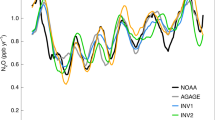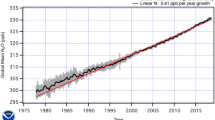Abstract
Nitrous oxide (N2O) fluxes for south-easternAustralia have been estimated using a combination ofthe in situ N2O and radon (Rn) measurementsmade at the Cape Grim Baseline Air Pollution Station,in north-west Tasmania. The average N2O fluxesfrom the south-eastern mainland of Australia and fromTasmania over the nine years of record analysed (1985–1993) have beenfound to be 130 ± 30 kgN km-2yr-1 and 160 ± 45 kgN km-2yr-1respectively. These fluxes are larger than expectedand a significant dependence of the flux on rainfallis observed, with greater fluxes in the spring (October–December) andduring periods of positive SouthernOscillation Index. A large flux (1,300 ± 500kgN km-2 yr-1) from a nearby island (KingIsland) was also estimated from the data record,indicating a strong source, although the small size ofthe island means that it is not a significant sourcefor Australia.
Similar content being viewed by others
References
Ambus, P. and Christensen, S., 1994: Measurement of N2O emission from a fertilized grassland–an analysis of spatial variability, J. Geophys. Res. 99, 16549–16555.
Beauchamp, E. G., Bergstrom, D. W., and Burton, D. L., 1996: Denitrification and nitrous oxide production in soil fallowed or under alfalfa or grass, Comm. Soil Sci. Plant Anal. 27, 87–99.
Bouwman, A. F., Fung, I., Matthews, E., and John, J., 1993: Global analysis of the potential for N2O production in natural soils, Glob. Biogeochem. Cycl. 7, 557–597.
Bouwman, A. F., Van der Hoek, K. W., and Olivier, J. G. J., 1995: Uncertainties in the global source distribution of nitrous oxide, J. Geophys. Res. 100, 2785–2800.
Branson, T. M., 1994: Analysis of CFC-11, CFC-12 and Methyl Chloroform in Melbourne Pollution Events, Honours (Batchelor of Env. Science), Environmental Sciences, University of Wollongong, pp.60.
Bureau of Meteorology, 1996: from http:www.bom.gov.au.
Butler, J. H., Elkins, J. W., and Thompson, T. M., 1989: Tropospheric and dissolved N2O of the East Pacific and East Indian Oceans during the El Nino Southern Oscillation Event of 1987, J. Geophys. Res. 94, 14865–14877.
Crutzen, P. J., 1970: The influence of nitrogen oxides on the atmospheric ozone content, Q. J. R. Meteorol. Soc. 96, 320–325.
Dick, A. L., Wilson, S. R., Took, P. P., and Fraser, P. J., 1996: Impact of regional sources on baseline measurements of nitrous oxide, in R. J. Francey, A. L. Dick, and N. Derek (eds.), Baseline Atmospheric Program (Australia) 1994–1995, Bureau of Meteorology in cooperation with CSIRO Division of Atmospheric Research, Melbourne, pp. 30–40.
Downey, A., Jasper, J. D., Gras, J. L., and Whittlestone, S., 1990: Lower tropospheric transport over the Southern Ocean, J. Atmos. Chem. 11, 43–68.
Flessa, H., Dorsch, P., and Beese, F., 1995: Seasonal variation of N2O and CH4 fluxes in differently managed arable soils in southern Germany, J. Geophys. Res. 100, 23115–23124.
Keller, M. and Reiners, W. A., 1994: Soil atmosphere exchange of nitrous oxide, nitric oxide, and methane under secondary succession of pasture to forest in the Atlantic Lowlands of Costa Rica, Glob. Biogeochem. Cycl. 8, 399–409.
Kilian, S. and Werner, D., 1996: Enhanced denitrification in plots of N-2-fixing faba beans compared to plots of a non-fixing legume and non legumes, Biol. Fert. Soils 21, 77–83.
Lavery, B. and Nicholls, N., 1994: Australian precipitation records from ten regionally representative stations, in T. A. Boden, D. P. Kaiser, R. J. Sepanski, and F.W. Stoss (eds.), Trends 1993, Carbon Dioxide Information and Analysis Center, Oak Ridge National Laboratories, Oak Ridge, Tenn., U.S.A., pp. 933–934.
Lui, S. C., McAfee, J. R., and Cicerone, R. J., 1984: Radon 222 and tropospheric vertical transport, J. Geophys. Res. 89, 7291–7297.
National Greenhouse Gas Inventory Committee, 1994a: Australian Methodology for the Estimation of Greenhouse Gas Emissions and Sinks, Workbook 5, Dept. of the Environment, Sports and Territories, Canberra, ACT, Australia.
National Greenhouse Gas Inventory Committee, 1994b: National Greenhouse Gas Inventory, 1988 and 1990, Dept. of Environment, Sports and Territories, Canberra, ACT, Australia.
Nevison, C. D., Weiss, R. F., and Erikson III, D. J., 1995: Global oceanic emissions of nitrous oxide, J. Geophys. Res. 100, 15809–15820.
Potter, C. S., Matson, P. A., Vitousek, P.M., and Davidson, E. A., 1996: Process modeling of controls on nitrogen trace gas emissions from soils worldwide, J. Geophys. Res. 101, 1361–1377.
Prather, M., 1985: Continental sources of halocarbons and nitrous oxide, Nature 317, 221–225.
Prather, M., 1988: European sources of halocarbon and nitrous oxide: Update 1986, J. Atmos. Chem. 6, 375–406.
Prather, M., Derwent, R., Ehhalt, D., Fraser, P., Sanhueza, E., and Zhou, X., 1995: Other trace gases and atmospheric chemistry, in J. T. Houghton, L. G. Meira Filho, J. Bruce, Hoesung Lee, B. A. Callander, E. Haites, N. Harris, and K. Maskell (eds.), Climate Change 1994, Published for the Intergovernmental Panel on Climate Change by Cambridge University Press, Cambridge, pp. 73–126.
Prinn, R., Cunnold, D., Rasmussen, R., Simmonds, P., Alyea, F., Crawford, A., Fraser, P., and Rosen, R., 1990: Atmospheric emissions and trends of nitrous oxide deduced from 10 years of ALEGAGE data, J. Geophys. Res. 95, 18369–18385.
Prinn, R. G., Simmonds, P. L., Rasmussen, R. A., Rosen, R. D., Alyea, F. N., Cardelino, C. A., Crawford, A. J., Cunnold, D. M., Fraser, P. J., and Lovelock, J. E., 1983: The atmospheric lifetime experiment 1. Introduction, instrumentation and overview, J. Geophys. Res. 88, 8353–8367.
Robertson, K., 1994: Nitrous oxide emission in relation to soil factors at low to intermediate moisture levels, J. Env. Quality 23, 805–809.
Robertson, K. and Klemedtsson, L., 1996: Assessment of denitrification in organogenic forest soil by regulating factors, Plant Soil 178, 49–57.
Schery, S. D., Whittlestone, S., Hart, K. P., and Hill, S. E., 1989: The flux of radon and thoron from Australian soils, J. Geophys. Res. 94, 8567–8576.
Shine, K. P., Derwent, R. G., Wuebbles, D. J., and Morcrette, J.-J., 1990: Radiative forcing to climate, in J. T. Houghton, G. J. Kenkins, and J. J. Ephreanus (eds.), Climate Change, The IPCC Assessment, Cambridge University Press, New York, pp. 45–68.
Sitaula, B. K. and Bakken, L. R., 1993: Nitrous oxide release from spruce forest soil–relationships with nitrification, methane uptake, temperature, moisture and fertilization, Soil Biol. Biochem. 25, 1415–1421.
Whittlestone, S., 1984: The Cape Grim radon monitor, in R. J. Francey (ed.), Baseline Atmospheric Program (Australia) 1981–82, Department of Science and Technology and Commonwealth Scientific and Industrial Research Organisation, Melbourne, Australia, pp. 46–50.
Whittlestone, S. and Zahorowski, W., 1995: The Cape Grim huge radon detector, in A. L. Dick and P. J. Fraser (eds.), Baseline Atmospheric Program (Australia) 1992, Bureau of Meteorology in cooperation with CSIRO Division of Atmospheric Research, Melbourne, pp. 26–30.
Author information
Authors and Affiliations
Rights and permissions
About this article
Cite this article
WILSON, S.R., DICK, A.L., FRASER, P.J. et al. Nitrous Oxide Flux Estimates for South-Eastern Australia. Journal of Atmospheric Chemistry 26, 169–188 (1997). https://doi.org/10.1023/A:1005828617711
Issue Date:
DOI: https://doi.org/10.1023/A:1005828617711




